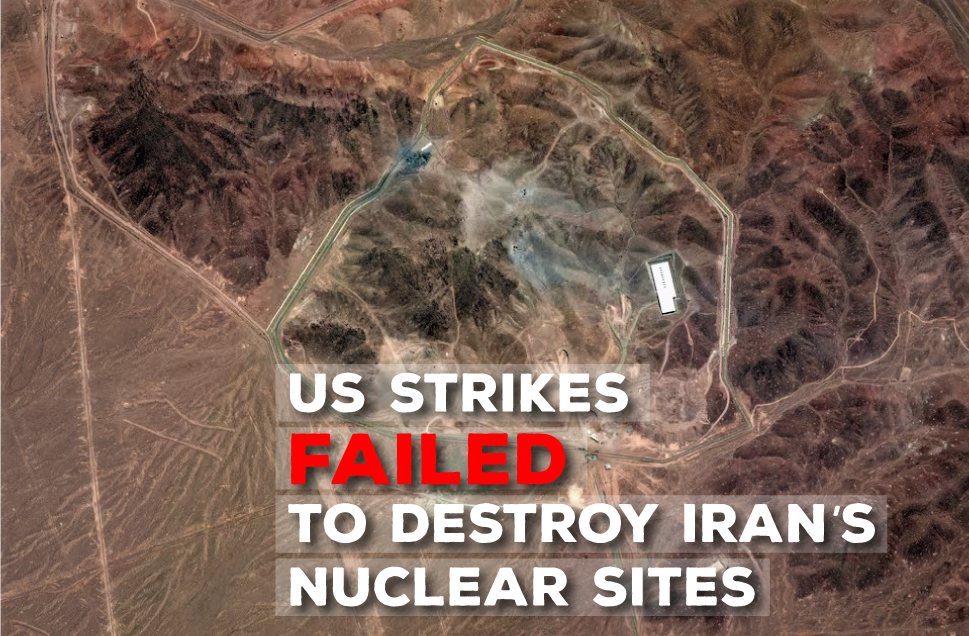US Strikes Failed to Destroy Iran’s Nuclear Sites
The recent United States military operation targeting Iran’s nuclear facilities has sparked intense debate following contradictory intelligence assessments that challenge President Trump’s claims of complete destruction. A classified Defense Intelligence Agency report reveals that the strikes only set back Iran’s nuclear program by months rather than obliterating it entirely, creating a significant diplomatic and political controversy.
Intelligence Assessment Contradicts Trump Administration Claims
A preliminary classified assessment from the Defense Intelligence Agency has concluded that US airstrikes on three Iranian nuclear facilities did not destroy the core components of Iran’s nuclear program and likely only delayed progress by several months12. This intelligence evaluation directly contradicts President Trump’s assertions that the attacks “completely and totally obliterated” Iran’s enrichment capabilities13.
The DIA assessment, which has not been publicly disclosed before, was generated following a damage evaluation conducted by US Central Command after the military actions1. Two individuals familiar with the evaluation noted that Iran’s reserves of enriched uranium remained largely intact, with one source mentioning that most centrifuges are “unharmed”12.
Operation Midnight Hammer: The Strategic Strike Details
The US military operation, codenamed Operation Midnight Hammer, targeted three critical Iranian nuclear sites on June 22, 2025: the Fordow Uranium Enrichment Plant, the Natanz Nuclear Facility, and the Isfahan Nuclear Technology Center45. The strikes employed fourteen 30,000-pound GBU-57A/B Massive Ordnance Penetrator “bunker buster” bombs carried by Northrop B-2 Spirit stealth bombers, along with Tomahawk missiles fired from submarines64.
President Trump announced the completion of the “very successful attack” via Truth Social, stating that all planes had safely exited Iranian airspace after delivering their full payload of bombs on the primary target at Fordow6. The operation marked the United States’ first offensive action in the Iran-Israel war, which began on June 13 with Israeli strikes47.
Trump’s Response to Intelligence Reports
Following the release of intelligence assessments questioning the operation’s effectiveness, President Trump launched a fierce defense on social media. In his characteristic style, Trump posted: “FAKE NEWS CNN, TOGETHER WITH THE FAILING NEW YORK TIMES, HAVE TEAMED UP IN AN ATTEMPT TO DEMEAN ONE OF THE MOST SUCCESSFUL MILITARY STRIKES IN HISTORY. THE NUCLEAR SITES IN IRAN ARE COMPLETELY DESTROYED! BOTH THE TIMES AND CNN ARE GETTING SLAMMED BY THE PUBLIC!”

Trump continued to assert that the strikes caused considerable damage, stating “I believe it has been utterly destroyed” and “Those pilots accurately targeted their objectives. Those targets obliterated and they deserve recognition”18. When questioned about Iran’s potential to reconstruct its nuclear program, Trump replied emphatically, “That site is buried. That site is demolished”1.
White House Pushes Back Against Intelligence Findings
The White House has strongly contested the DIA assessment, with Press Secretary Karoline Leavitt calling it “categorically incorrect” and suggesting it was leaked by “an anonymous, low-ranking member of the intelligence community”19. Leavitt characterized the leak as “a blatant attempt to undermine President Trump and to discredit the courageous pilots who executed a flawlessly conducted mission to dismantle Iran’s nuclear program”12.
The administration maintains that “everyone knows what happens when fourteen 30,000-pound bombs are perfectly targeted: total destruction”110. Defense Secretary Pete Hegseth also claimed on Sunday that Iran’s nuclear ambitions had been “obliterated”110.
Iran’s Nuclear Capabilities Before the Strikes
Prior to the US strikes, Iran possessed significant nuclear capabilities that raised international concerns. According to the International Atomic Energy Agency, Tehran had an estimated 408.6 kilograms of uranium enriched to 60% purity1112. This material, if further refined to 90% weapons-grade levels, would theoretically be sufficient to produce more than nine nuclear bombs1113.
Iran’s nuclear program centered around three major facilities targeted in the strikes. The Fordow facility, built deep inside a mountain near Qom, housed advanced IR-6 centrifuges for uranium enrichment1415. Natanz, Iran’s main enrichment site, contained thousands of centrifuges in underground halls and served as the “workhorse” of Iran’s enrichment program1614. Isfahan functioned as a major nuclear research center and uranium conversion facility1718.
Damage Assessment and Remaining Capabilities
The DIA assessment indicates that while the strikes caused significant damage to surface structures and sealed entrances to underground facilities, the core enrichment infrastructure remained largely intact1199. At Fordow, the most heavily fortified site, satellite imagery shows crater impacts where bunker-buster bombs penetrated the mountain, but the underground enrichment halls located hundreds of feet beneath the surface appear to have survived915.
International Atomic Energy Agency Director General Rafael Grossi confirmed that all three sites were hit but noted that “no one, including the IAEA, is in a position to assess the underground damage” at the most sensitive locations2017. The IAEA chief estimated the damage as “very significant” due to “the explosive payload used and the extreme sensitivity of centrifuges to vibrations”17.
Strategic Implications for Iran’s Nuclear Timeline
Intelligence analysts suggest that Iran’s nuclear program timeline has been extended by only a few months rather than years21910. The DIA assessment provides a range of possibilities for Iran to regain access to underground facilities and resume operations, ranging from several months to less than a year9. Some of Iran’s enriched uranium stockpile was reportedly moved to undisclosed locations before the strikes, limiting the material destruction1995.
Former officials noted that any accelerated effort by Iran to create a nuclear weapon would likely result in a relatively basic device, as the development of miniaturized warheads would pose significant challenges19. However, current assessments indicate Iran could still potentially enrich enough uranium for multiple weapons within weeks if it chose to do so13.
Congressional Briefings and Political Reactions
Scheduled classified briefings for both House and Senate members regarding the operation were canceled on Tuesday, with the Senate briefing rescheduled for Thursday119. Democratic Representative Pat Ryan criticized the cancellation, suggesting that “Trump just canceled a classified House briefing on the Iran strikes” because his team “knows they cannot substantiate his boastful claims”1.
The political reaction has been largely divided along party lines, with Congressional Republicans supporting Trump’s action while many Democrats and some Republicans expressed concerns about the constitutionality of the move and its long-term effects421.
Ceasefire and Regional Implications
The strikes preceded a dramatic ceasefire announcement between Israel and Iran, brokered by Trump and Qatari leadership. The agreement involved two 12-hour ceasefire periods and officially ended what Trump termed “THE 12 DAY WAR”721. However, the fragility of the ceasefire was immediately apparent, with both sides accused of violations shortly after it was supposed to take effect21.
The broader regional implications of the strikes continue to unfold, with mixed international reactions and ongoing concerns about potential escalation despite the ceasefire agreement422.
Conclusion
The controversy surrounding the US strikes on Iran’s nuclear facilities highlights the complex intersection of military action, intelligence assessment, and political messaging in contemporary foreign policy. While President Trump maintains that the operation achieved complete destruction of Iran’s nuclear capabilities, classified intelligence reports suggest a more limited impact that may only delay Iran’s nuclear timeline by months rather than permanently dismantling the program1210. The ongoing debate underscores the challenges of accurately assessing underground facility damage and the political sensitivities surrounding nuclear non-proliferation efforts in the Middle East.
Read more Political News HERE




